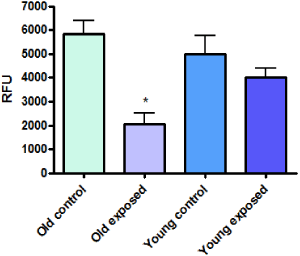Effect of exposure to novelty and open space on Reactive Oxygen Species production (ROS) in young and aged Wistar rats In this study we investigated the effect of anxiety induced by exposure to novelty in an open space on ROS production in young (2-3 months) and aged (24 months+) male Wistar rats. Half of the group of rats from each age group was exposed to a 3D spatial navigation apparatus in a unique session for 12 min while the other half remained in their home cage (Ennaceur et al., 2006). At the end of a test session, one control and one experimental were killed immediately, and their forebrains rapidly removed and placed in isolation buffer containing 220mM mannitol, 60mM sucrose, 5mM Tris-HCl, 0.5mM EGTA and 1mg ml-1 bovine serum albumin (BSA; fatty acid free) pH 7.4. Homogenates were centrifuged at 2,000 rpm for 6 min at 0-4°C and the resulting supernatant decanted off and spun for 8 min at 10,000 rpm. The pellet produced was resuspended in 9 ml of buffer and aliquots layered onto 10 ml ice-cold Percoll solution containing 250mM sucrose, 5mM Tris-HCl, 0.1mM EGTA and 18% (w/v) Percoll, pH 7.4. The resulting density gradient was centrifuged at 10,000 rpm for 45 min. A loose mitochondrial pellet, free from most contamination, was formed at the bottom of the tube with a synaptosomal fraction forming a separate layer at the top of the tube. The two layers were then isolated and centrifuged at 10,000 rpm in isolation buffer minus EGTA (incubation buffer) to remove the Percoll. 
Figure 1. The effect of OST on ROS production of mitochondrial complex II depending on age in male Wistar rats (n=6), (sacrificed immediately after OST). Graph shows mean ± S.E.M, where * indicates P<0.05 compared to control. Data was statistically analyzed using unpaired t-test. The results from the OST show that the aged rats are certainly more anxious than their young counterparts, as they exhibit a lack of exploratory behaviour. |
|

